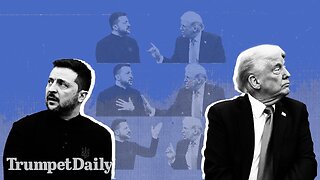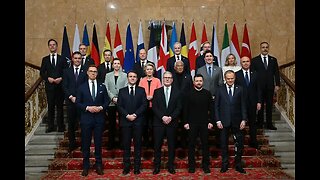Premium Only Content

China Threat: Germany 2.0
Cause Before Symptom - With Your Host James Carner
China Threat: Germany 2.0
China isn’t playing around. I do believe they purposely crashed American AI and NVIDIA with DeepSeek. And since we know from my last show that Obama, Bill & Hillary sold state secrets to them, they have the ability to hack our military helicopters. Is this by design? What does China gain by crashing NVIDIA and our AI market? Nvidia dominated China's AI chip market with a more than 90% share before this crash. China has had a monopoly investigation into NVIDIA for a few years now.
China’s State Administration of Market Regulation is investigating American technology giant Nvidia for potential violation of anti-monopoly laws and an agreement on Nvidia’s acquisition of Mellanox Technologies in 2020. The first allegation makes sense only as retaliation against the latest round of US sanctions on China, but the second may hold water. Nvidia is disputing the allegations.
In any case, Nvidia has denied rumors that it plans to reduce sales to China, which accounted for 15% of its revenue in the three months to October (Nvidia’s fiscal third quarter). In fact, Nvidia is expanding its presence in China with a focus on areas not subject to export controls, including autonomous driving.
Now, the U.S. is currently investigating if DeepSeek smuggled advanced Nvidia GPUs into China. The U.S. government is currently looking into whether Chinese startup DeepSeek had illegally obtained Nvidia GPUs through middlemen in Singapore. The U.S. has strict curbs on China for advanced chips to make sure the former maintains its technology supremacy.
DeepSeek also claimed that it did all of this with just 2000 Nvidia H800 GPUs and just around $6 million, a fraction of what OpenAI needed. This raised many eyebrows about whether DeepSeek really did something different from OpenAI and other U.S. AI companies and whether it's genuinely possible to train AI models with much fewer resources.
Microsoft and OpenAI are investigating whether DeepSeek was trained on stolen U.S. data as well. Microsoft has earmarked $80 billion for AI in its current fiscal year, while Meta has pledged as much as $65 billion. That is a far cry from the roughly $6 million DeepSeek said it has spent to develop its AI model. That’s funny, didn’t trump just pledge $500 billion for Stargate? This pays back Microsoft, Meta OpenAI, for the DeepSeek release. This is a clue that Trump knew it was coming and gave back all their investments using American Taxpayer money. Trump himself has said that his involvement in the project is because of an “emergency” situation. Since the tech giants helped him get in as Elon said they cheated, they wanted their money back since China crashed it.
I know, this is speculation, but it’s really weird timing. NVIDIA just became the world’s largest company at a 3.4 trillion market cap last November (just a few months ago) taking over Apple’s position. According to available information, between the three firms, State Street, BlackRock, and Fidelity collectively own around 20% of Apple stock, with BlackRock holding the largest stake at roughly 6-7% of Apple shares, followed by State Street with a smaller percentage; Fidelity also holds a significant portion of Apple shares through various funds, though not as large as the other two institutions. NVIDIA is also owned by BlackRock, Vanguard and Fidelity whom all have controlling interest. It wouldn’t surprise me if Trump just gives that 500 billion to them for this entire fiasco. Basically it’s just another bailout.
But China stands in the way of profit for the American AI and chip manufacturers. They are a threat because they can do things faster and cheaper. The DeepSeek release just showed the investors that a 60 billion dollar AI can be done with 6 million. Acculturation numbers of course.
Germany Yesterday American Today
The parallels between pre-World War I Germany and contemporary America are often discussed in academic and policy circles, but it’s important to approach the comparison with nuance. While there are some similarities, there are also significant differences in context, institutions, and global dynamics. Let’s break this down:
Similarities Between Pre-WW1 Germany and Contemporary America
1. High Levels of Debt:
* Germany before WW1: Germany had accumulated significant debt due to rapid industrialization, military buildup (especially under Kaiser Wilhelm II), and social welfare programs. The government relied heavily on borrowing to fund its ambitions.
* America Today: The U.S. national debt is over $31 trillion (as of 2023), driven by decades of deficit spending, tax cuts, military expenditures, and responses to crises like the 2008 financial crash and the COVID-19 pandemic.
2. Economic Inequality and Social Tensions:
* Germany before WW1: Rapid industrialization created wealth disparities, and the working class increasingly demanded better conditions. This led to political instability and the rise of socialist movements.
* America Today: Income inequality in the U.S. has grown significantly since the 1970s, with wealth concentrated at the top. This has fueled political polarization and social unrest, similar to pre-WW1 Germany.
3. Geopolitical Ambitions and Military Spending:
* Germany before WW1: Germany sought to challenge Britain’s global dominance, leading to a naval arms race and heightened tensions. Military spending strained the economy.
* America Today: The U.S. maintains a massive military budget (over $800 billion annually) to sustain its global hegemony, particularly in response to challenges from China and Russia. This spending contributes to the debt burden.
4. Global Economic Competition:
* Germany before WW1: Germany was a rising industrial power competing with Britain and France for markets and resources, which contributed to economic and political friction.
* America Today: The U.S. faces economic competition from China, which is challenging its technological and economic dominance, particularly in areas like semiconductors, AI, and green energy.
Key Differences
1. Global Financial Systems:
* Germany before WW1: The global financial system was based on the gold standard, which limited the ability of governments to manipulate their currencies or engage in deficit spending. Germany’s debt was harder to manage under these constraints.
* America Today: The U.S. dollar is the world’s reserve currency, and the global financial system is based on fiat money. This allows the U.S. to borrow extensively at low interest rates and monetize its debt through mechanisms like quantitative easing.
2. Political Systems and Institutions:
* Germany before WW1: Germany was an autocratic empire with limited democratic institutions. Decision-making was centralized, and the Kaiser had significant power, which contributed to reckless policies.
* America Today: The U.S. is a democratic republic with checks and balances. While political polarization is a concern, the system is designed to prevent unilateral decisions like going to war without broad consensus.
3. Global Interdependence:
* Germany before WW1: The global economy was less interconnected, and trade wars (e.g., tariffs) were more common. This contributed to a zero-sum mentality and heightened tensions.
* America Today: The global economy is highly interdependent, with complex supply chains and financial ties. A major war would have catastrophic economic consequences for all parties, creating strong disincentives for conflict.
4. Debt Ownership:
* Germany before WW1: Much of Germany’s debt was held domestically or by foreign creditors, making it vulnerable to financial crises.
* America Today: A significant portion of U.S. debt is held domestically (e.g., by the Federal Reserve, pension funds, and individual investors), and the dollar’s status as the reserve currency ensures continued demand for U.S. Treasuries.
Could War Be a Way Out of Debt for America?
The idea that war could "solve" debt problems is a controversial and often oversimplified argument. Historically, wars have sometimes led to economic booms (e.g., through industrial mobilization), but they also come with enormous costs:
* Germany’s Experience: World War I did not solve Germany’s debt problems; instead, it led to hyperinflation, economic collapse, and the eventual rise of the Nazi regime. War is not a sustainable solution to debt.
* America’s Position: The U.S. is unlikely to resort to war as a way out of debt. Modern wars are incredibly costly, and the U.S. economy is deeply integrated into the global system. A major conflict would likely exacerbate economic problems rather than solve them.
Instead, the U.S. has other tools to manage its debt, such as:
* Economic Growth: Stimulating growth through innovation, infrastructure investment, and education.
* Tax and Spending Reforms: Addressing structural deficits through balanced fiscal policies.
* Monetary Policy: The Federal Reserve can manage inflation and interest rates to ensure debt remains sustainable.
While there are some parallels between pre-WW1 Germany and contemporary America—such as high debt levels, economic inequality, and geopolitical competition—the differences in context and institutions make a direct comparison problematic. War is not a viable or likely solution to America’s debt challenges. Instead, the focus should be on sustainable economic policies, global cooperation, and addressing the root causes of inequality and political polarization.
Let’s dive deeper into specific aspects of the comparison between pre-World War I Germany and contemporary America, focusing on economic policies, geopolitical strategies, and historical case studies. This will help us better understand the parallels and differences, as well as the lessons that can be drawn from history.
1. Economic Policies and Debt Management
Germany Before WW1
* Industrialization and Debt: Germany underwent rapid industrialization in the late 19th and early 20th centuries, which required significant investment in infrastructure, technology, and education. The government borrowed heavily to fund these projects, as well as its military buildup.
* Social Welfare Programs: Under Chancellor Otto von Bismarck, Germany introduced some of the world’s first social welfare programs (e.g., pensions, health insurance) to placate the working class and counter the rise of socialism. These programs were expensive and added to the debt burden.
* Gold Standard Constraints: Germany, like other major powers, was on the gold standard, which limited its ability to print money or devalue its currency. This made debt management more challenging, especially during economic downturns.
America Today
* Deficit Spending: The U.S. has run budget deficits for decades, driven by tax cuts, military spending, and social programs. The COVID-19 pandemic exacerbated this trend, with trillions of dollars spent on stimulus packages and relief programs.
* Monetary Flexibility: Unlike pre-WW1 Germany, the U.S. operates under a fiat currency system, allowing the Federal Reserve to print money and engage in quantitative easing. This has kept interest rates low and made debt servicing more manageable.
* Global Demand for U.S. Debt: The U.S. dollar’s status as the world’s reserve currency ensures strong demand for U.S. Treasuries, even as debt levels rise. This gives the U.S. more leeway in managing its debt compared to pre-WW1 Germany.
Key Insight: While both Germany and the U.S. have relied on debt to fund their ambitions, the U.S. has more tools at its disposal to manage debt, thanks to its flexible monetary system and the dollar’s global role.
2. Geopolitical Strategies and Military Spending
Germany Before WW1
* Weltpolitik: Under Kaiser Wilhelm II, Germany pursued an aggressive foreign policy (Weltpolitik) aimed at securing its “place in the sun” as a global power. This included building a large navy to challenge British dominance and acquiring colonies.
* Naval Arms Race: Germany’s naval buildup, particularly the construction of dreadnoughts, led to an arms race with Britain. This was both a symbol of national pride and a significant drain on resources.
* Alliances and Rivalries: Germany’s alliances (e.g., with Austria-Hungary) and rivalries (e.g., with France and Russia) created a volatile geopolitical environment. The assassination of Archduke Franz Ferdinand in 1914 triggered a chain reaction that led to WW1.
America Today
* Global Hegemony: The U.S. has been the world’s dominant superpower since the end of World War II, maintaining a network of alliances (e.g., NATO) and military bases around the globe.
* Military Spending: The U.S. spends more on its military than the next 10 countries combined, with a focus on maintaining technological superiority and countering rivals like China and Russia.
* Pivot to Asia: In recent years, the U.S. has shifted its strategic focus to the Indo-Pacific region, where it seeks to counter China’s growing influence.
Key Insight: Both Germany and the U.S. have used military power to assert their global influence, but the U.S. operates in a more interconnected and nuclear-armed world, where the costs of major conflict are far higher.
3. Historical Case Studies
The Role of War in Debt Resolution
* Germany’s Experience: World War I did not resolve Germany’s debt problems; instead, it led to economic collapse, hyperinflation, and the Treaty of Versailles, which imposed reparations that further crippled the economy. The war ultimately exacerbated Germany’s financial woes and contributed to the rise of extremism.
* America’s Experience: The U.S. emerged from World War II as the world’s leading economic power, but this was due to its unique position as a creditor nation and the destruction of rival economies. Modern wars (e.g., Iraq, Afghanistan) have been costly and have added to the national debt.
Lesson: War is not a reliable solution to debt problems. In fact, it often creates new economic challenges and long-term instability.
Economic Inequality and Political Instability
* Germany Before WW1: Economic inequality and the rise of socialist movements created political tensions that the Kaiser’s government struggled to manage. This contributed to a sense of crisis and the eventual collapse of the empire.
* America Today: Rising inequality and political polarization have led to social unrest and a loss of faith in institutions. While the U.S. has not faced a revolution, the potential for instability remains a concern.
Lesson: Addressing inequality and fostering social cohesion are critical to maintaining political stability and economic resilience.
4. Lessons for America
1. Avoid Overreliance on Military Solutions: While military power is important, it should not be seen as a solution to economic problems. The costs of war often outweigh the benefits, especially in a globalized world.
2. Invest in Sustainable Growth: The U.S. should focus on long-term investments in infrastructure, education, and technology to drive economic growth and reduce debt burdens.
3. Address Inequality: Tackling income and wealth inequality is essential to maintaining social stability and ensuring broad-based prosperity.
4. Strengthen Global Cooperation: In an interconnected world, the U.S. should work with allies and rivals to address global challenges (e.g., climate change, pandemics) rather than resorting to zero-sum competition.
The comparison between pre-WW1 Germany and contemporary America highlights the dangers of high debt, inequality, and geopolitical overreach. However, the U.S. has significant advantages, including its flexible monetary system, democratic institutions, and global leadership role. By learning from history and adopting prudent policies, the U.S. can avoid the pitfalls that led Germany down a destructive path.
Germans on social media are calling America Germany 2.0 and Elon’s cars Swazticars. They have a historical insight and experience.
How the "America as Germany 2.0" Analogy Appears in Public Discourse
1. Economic Parallels:
* Debt and Spending: Many critics point to America’s rising national debt and deficit spending as reminiscent of Germany’s pre-WW1 economic challenges. Social media users often highlight the U.S. debt-to-GDP ratio and compare it to historical examples of fiscal mismanagement.
* Inequality: Discussions about wealth inequality in the U.S. often draw parallels to the social tensions in pre-WW1 Germany. Memes, infographics, and threads on platforms like Twitter (X) and Reddit frequently emphasize the growing gap between the rich and poor.
2. Geopolitical Tensions:
* Rivalry with China: The U.S.-China rivalry is often compared to the Anglo-German naval arms race before WW1. Social media users, particularly in geopolitical circles, debate whether this competition could escalate into conflict.
* Military Spending: Critics of U.S. military expenditures often argue that the country is overextending itself, similar to Germany’s pre-WW1 militarism. Hashtags like #MilitaryIndustrialComplex and #EndlessWars are common in these discussions.
3. Political Polarization:
* Rise of Populism: The rise of populist movements in the U.S. (both on the left and right) is sometimes compared to the political fragmentation and extremism in pre-WW1 Germany. Social media platforms are rife with debates about whether the U.S. is heading toward a similar breakdown of democratic norms.
* Erosion of Trust: Online commentators often highlight declining trust in institutions (e.g., government, media) as a parallel to the political instability in Germany before WW1.
4. Cultural and Social Unrest:
* Protests and Unrest: Events like the January 6 Capitol riot and widespread protests over racial injustice have led some social media users to draw comparisons to the social upheaval in pre-WW1 Germany.
* Nationalism: The resurgence of nationalist rhetoric in the U.S. is often compared to the aggressive nationalism that fueled Germany’s pre-WW1 ambitions.
Platforms Where This Discussion Thrives
1. Twitter (X):
* Twitter is a hub for political and economic commentary. Hashtags like #AmericaDecline, #Germany2.0, and #DebtCrisis often surface in discussions about the U.S.’s trajectory.
* Influential figures in economics, history, and politics frequently tweet about these parallels, sparking debates among their followers.
2. Reddit:
* Subreddits like r/economy, r/history, and r/politics often feature threads comparing the U.S. to pre-WW1 Germany. These discussions are typically more detailed and include links to articles, books, and academic studies.
* Users often share memes and infographics to illustrate their points, making the comparison accessible to a broader audience.
3. YouTube:
* Political commentators and historians on YouTube frequently create videos analyzing the parallels between the U.S. and pre-WW1 Germany. These videos often go viral, especially among audiences interested in geopolitics and economic history.
* Channels like RealLifeLore, Kraut, and Whatifalthist have explored this topic in depth.
4. TikTok:
* TikTok creators use short, engaging videos to explain complex historical and economic concepts. The “America as Germany 2.0” analogy is often simplified into digestible content, making it popular among younger audiences.
* Hashtags like #HistoryTok and #EconTok are used to categorize these videos.
Common Arguments For and Against the Analogy
Arguments For:
* Historical Cycles: Some argue that history repeats itself, and the U.S. is following a similar path of decline due to debt, inequality, and geopolitical overreach.
* Erosion of Democracy: Critics point to the erosion of democratic norms and rising authoritarianism as signs that the U.S. could face a crisis similar to Germany’s collapse into fascism.
* Global Power Shifts: The rise of China is often compared to the rise of Germany as a challenger to British hegemony, suggesting that the U.S. could face a similar decline.
Arguments Against:
* Unique Context: Many historians and economists argue that the U.S. operates in a fundamentally different global system, with tools (e.g., fiat currency, reserve currency status) that Germany lacked.
* Institutional Resilience: The U.S. has stronger democratic institutions and a longer history of political stability, making a collapse like Germany’s less likely.
* Global Interdependence: The interconnected nature of the modern global economy creates strong disincentives for major conflict, unlike the zero-sum dynamics of the early 20th century.
Key Figures and Influencers Discussing This Topic
1. Niall Ferguson: The historian has written extensively about the parallels between the decline of empires, including pre-WW1 Germany and contemporary America.
2. Peter Turchin: A scholar who studies historical cycles of inequality and political instability, Turchin has warned that the U.S. could face a crisis similar to pre-revolutionary societies.
3. Ray Dalio: The billionaire investor has compared the U.S. to past empires in decline, citing debt, inequality, and geopolitical tensions as key factors.
The analogy of America becoming “Germany 2.0” is a provocative and often debated topic on social media and in public discourse. While there are some valid parallels, the differences in context and institutions make the comparison imperfect. The discussion reflects broader concerns about debt, inequality, and geopolitical tensions, but it’s important to approach these analogies with caution and nuance.
If America goes to war, there goes the money stream. Even in 133% in debt, America thrives and still is the richest country in the world. China is tired of the oppression of only getting 10% of the market share for their patents. So they crashed American AI investments and stock market as leverage. They will offer AI for free for all small to medium sized business and now America lost its grip on it.
Since Trump is unhinged and hates to lose, this maniac could approve war with China. All they need is an act of war from China. They could use the helicopter hack on innocent American civilians as the excuse. But if we do, it’s World War III. This bad news for BlackRock, Vanguard & State Street. They are just share holders of big companies. This takes away their power structure. What’s left after thermonuclear winter are countries. Not corporations. Maybe this is why Zuckerberg has his own bunker. He knows it’s over if the military industrial complex goes for it.
So, war just isn’t an option for the big hedge fund investment managers (it’s bad for business). But it’s great for the black nobility families. Rumor is they have underground bunkers in Italy which are nuclear bunker buster proof. We have no proof.
In the book Destiny for War: Can America and China Escape the Thucydides Trap by, Graham Allison, examines the escalating tensions between the United States and China, arguing that their current trajectory risks war unless significant steps are taken to prevent it. The author uses Thucydides' Trap, the historical pattern of conflict between a rising power and a ruling power, as a framework to analyze the situation. The text explores China's remarkable economic and military growth, comparing it to historical power transitions, particularly the rivalry between Athens and Sparta, and Britain and Germany before World War I. Allison presents various scenarios illustrating potential flashpoints and emphasizes the need for strategic thinking and negotiation to avert conflict. Finally, the text offers potential solutions, including accommodation and negotiated agreements, to manage the rivalry and ensure peace.
Allison utilizes Thucydides's analysis of the Peloponnesian War to argue that a similar dynamic, a rising power challenging an established hegemon, is a major driver of war.
Key Themes
1. Thucydides's Trap: The central concept is the idea that when a rising power threatens to displace a ruling power, the resulting structural stress makes violent conflict more likely. As the text states, "The core concept of Thucydides’s Trap is that the structural stress caused by a rising power inevitably challenges a ruling one." This "trap" is not a guarantee of war, but it creates a dangerous environment ripe for conflict.
2. The Dynamic of Rising and Ruling Powers: The book emphasizes the psychological and political factors that exacerbate the tension between rising and ruling powers. The rising power often feels entitled to greater influence and respect, while the ruling power becomes increasingly insecure and wary of the rising power's ambitions. "The thought that Germany might elbow Britain from the top spot… grew ever more determined to secure Germany’s rightful place in the sun."
3. The Significance of Sea Power: Drawing from Alfred T. Mahan's theories, the text emphasizes the importance of naval power in projecting influence and securing national greatness. Many rising powers (e.g., England, Germany, and now China) have sought to challenge the established order by building up their naval strength. As Kaiser Wilhelm II said, his goal was "to possess as fine a navy as the English."
4. The Role of Domestic Politics: The book highlights how domestic political pressures often influence a nation's foreign policy decisions, particularly in times of perceived existential threats. Weltpolitik, for example, "was as much about domestic politics as about the world beyond Germany’s borders." Bismarck's manipulation of a war with France also serves as an example.
5. Arms Races and Escalation: The document explores how arms races, particularly naval races, can contribute to tensions and increase the risk of war. "With every rivet that von Tirpitz drove into his ships of war, he united British opinion…The hammers that clanged at Kiel and Wilhelmhaven were forging the coalition of nations by which Germany was to be resisted and finally overthrown." The naval buildup is seen as exacerbating the crisis rather than creating peace.
6. The Potential for Preemptive Actions: The text touches on the idea of preventive war, where a country launches an attack against a rising power because they believe it's only a matter of time before that power becomes a major threat. The British considered this against Germany, with one prominent naval leader saying "if you want to smash up the German Fleet, I am ready to do so now. If you wait five or six years, it will be a much more difficult job."
Important Ideas and Facts
* Historical Case Studies: The book uses numerous historical examples to illustrate the dynamics of rising and ruling powers, including:
* Dutch Republic vs. England: A mid-17th century clash between the dominant Dutch naval power and a rising England. Both nations saw their "destiny… upon the water, and that mastery of the seas was a necessity of national existence."
* Germany vs. Great Britain: The late 19th/early 20th century naval race and other tensions leading up to WWI. "Germany’s growing wealth and power fueled its naval expansion, and German naval supremacy was 'incompatible with the existence of the British Empire.'"
* Sweden vs. Hapsburgs: A 17th century conflict where Sweden's rise and Hapsburg anxieties led to war. "Gustavus began to see a military standoff as ‘inevitable’"
* Japan vs. Russia (and China): Early 20th century wars that highlight Japan's ambitions and their rise to regional power.
* Various Cases of Nuclear Proliferation: The text uses nuclear proliferation as a modern example of when "a competitor stood on the threshold of acquiring nuclear weapons," and the ruling power considered preemptive attack
* Germany's Rise: After unification, Germany experienced rapid economic and military growth, which led to the pursuit of "Weltpolitik" and a naval buildup designed to challenge Great Britain. "The Germans were no longer the objects of other people’s history but the subject of their own story of national greatness." The Kaiser wanted "his country to become a ‘World Power’—a status that required a formidable navy."
* The Naval Race: Tirpitz, head of the German Navy, believed a naval force "equally as strong as England’s," would give Germany more political power and the ability to challenge British dominance. However, the naval buildup was perceived as threatening by Britain.
* China's Present Rise: The text notes that Chinese strategists are influenced by Mahan's theories about the importance of naval power, making a conflict over maritime control a real possibility. China has a "deadly serious commitment to building a modern military that can take on and defeat all adversaries—in particular the United States."
* The Importance of Institutions and Culture: The book also acknowledges that certain factors can mitigate the risk of war, such as membership in international institutions, and deeply engrained cultural norms. "States can be embedded in larger economic, political, and security institutions that constrain historically 'normal' behaviors."
"Destined for War" highlights the recurring danger of conflict that arises when a rising power challenges a ruling power. The text uses historical examples to show the dangers inherent in periods of power transition, and how misperceptions, national pride, and economic competition can escalate tensions. The book cautions that while war is not inevitable, such structural stresses between nations require careful management to avoid a catastrophic outcome. While external events matter, "our destiny lies 'not in our stars, but in ourselves.'"
China has been an enemy of Trump since he took office in 2016. America is losing its power and grip on control and is showing its anger at dissenters. America decided to tariff itself, lock up the borders and take on the world. Trump thinks he is that man that can bring us back to the good ‘ole days when we were young and wild. Trump came out swinging by telling Panama, Canada and Greenland that they belong to him. America needs assets. In order for the federal reserve to balance the books, it needs resources and land. Any one of these places will satisfy its investors. The Federal Reserve is bankrupt and their investors are asking for their money.
If Trump can get one of these three money makers, it could satisfy the 12 federal reserve investors whom are foreign and domestic private banks. So if Trump can’t get Canada, Greenland or Panama, my guess is he has no other choice but to plant a false flag on American soil and blame China just like we did at the Gulf of Tonkin.
source
https://www.foxnews.com/live-news/military-helicopter-crash-dc-airport
https://asiatimes.com/2024/12/whats-behind-chinas-nvidia-monopoly-investigation/
https://www.neowin.net/news/the-us-is-currently-investigating-if-deepseek-smuggled-advanced-nvidia-gpus-into-china/
https://www.neowin.net/news/the-us-is-currently-investigating-if-deepseek-smuggled-advanced-nvidia-gpus-into-china/
https://www.neowin.net/news/report-microsoft-openai-investigating-whether-deepseek-was-trained-on-stolen-us-data/
https://www.forbes.com/sites/bernardmarr/2025/01/23/what-does-trumps-500-billion-stargate-mean-for-the-world-of-ai/
https://insiderpaper.com/chinas-xi-calls-for-troops-to-boost-war-preparedness/#google_vignette
https://www.foreignaffairs.com/united-states/xi-jinping-says-he-preparing-china-war
https://unherd.com/2023/07/the-clue-china-is-preparing-for-war/
Destiny for War - Can America and China Escape the -- Graham Allison -- 2017 -- Houghton Mifflin Harcourt Publishing Company
-
 LIVE
LIVE
LFA TV
1 day agoEurope’s Relationship With America Is Over | TRUMPET DAILY 3.3.25 7PM
236 watching -
 LIVE
LIVE
Quite Frankly
5 hours ago"European Deth Pact, Blackout Data Breach, More" ft. Jason Bermas 3/3/25
828 watching -
 LIVE
LIVE
2 MIKES LIVE
2 hours ago2 MIKES LIVE #187 Deep Dive Monday!
112 watching -
 44:25
44:25
CatfishedOnline
3 hours agoRacist Lady Shocked After Sending Money to a Nigeria Romance Scammer
3.34K2 -
 56:45
56:45
VSiNLive
3 hours agoFollow the Money with Mitch Moss & Pauly Howard | Hour 1
30.9K -
 2:28:18
2:28:18
Nerdrotic
6 hours ago $3.97 earnedOscars Aftermath | Super Chat Square Up - Nerdrotic Nooner 469
42.5K13 -
 1:09:41
1:09:41
Sean Unpaved
7 hours ago $4.00 earnedUnpaved
50.4K4 -
 2:01:02
2:01:02
Revenge of the Cis
5 hours agoEpisode 1455: Cover Up
34.3K2 -
 1:01:18
1:01:18
In The Litter Box w/ Jewels & Catturd
1 day agoUK DUPLICITY | In the Litter Box w/ Jewels & Catturd – Ep. 753 – 3/3/2025
74.8K39 -
 1:35:28
1:35:28
Vigilant News Network
7 hours agoHillary CRUSHED by Hegseth After She Suggests His KREMLIN Ties | The Daily Dose
43.5K18